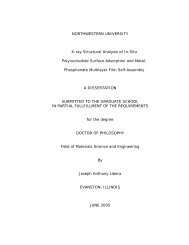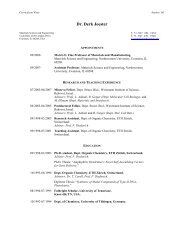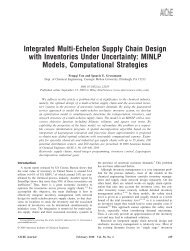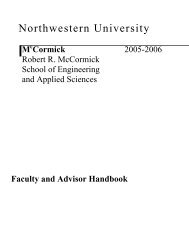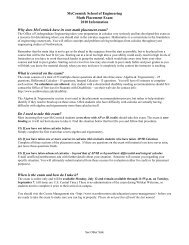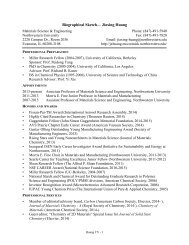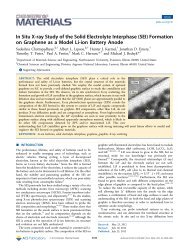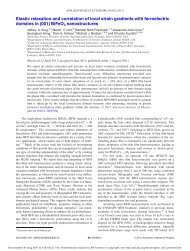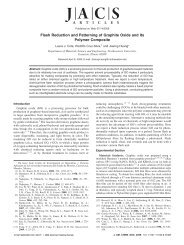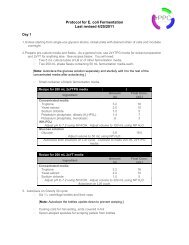Community-Based Operations Research - Humanitarian Logistics
Community-Based Operations Research - Humanitarian Logistics
Community-Based Operations Research - Humanitarian Logistics
Create successful ePaper yourself
Turn your PDF publications into a flip-book with our unique Google optimized e-Paper software.
Johnson and Smilowitz: <strong>Community</strong>-<strong>Based</strong> <strong>Operations</strong> <strong>Research</strong>Tutorialsin <strong>Operations</strong><strong>Research</strong>, c○ 2007 INFORMS 103(Western [95], Bureau of Justice Statistics [17]). The number of U.S. households with atleast moderate housing burdens (at least 30% of income) rose from 31to 34 million between2001and 2004, whereas average commute times increased at greater rates for lower-incomefamilies than for higher-income families (Joint Center for Housing Studies [47]).<strong>Research</strong> on social issues such as those described above has traditionally been descriptivein nature, and concentrated within the social sciences, urban planning, and relateddisciplines; they have tended to receive somewhat less attention from disciplines such asoperations research/management science (OR/MS) whose models and methods tend to bemore prescriptive. We assert that an adaptation of previously identified domains of OR/MS,which we denote as community-based operations research, is well positioned to provide modelsand analytic methods that can provide guidance to individuals, government, and nongovernmentalorganizations that seek to address these problems. In this tutorial, we describethe characteristics of problems that fall within the scope of community-based OR, developa taxonomy of problem areas, provide a review of related OR/MS research literature, andexplore two case studies of community-based OR applications. Finally, we identify somenext steps for research and practice in this area.The scope of this tutorial is largely limited to the U.S., as American political and socialvalues, and demographic and economic characteristics may differ from other developed countriesin certain ways relevant to community-based OR. We focus on the last 30 or so years ofresearch and applications, the scope of time within which “public-sector operations research”has become a well-defined domain. We define OR/MS broadly to include prescriptive decisionmodels as well as descriptive models that are directly applicable to decision modeling.Evidence to support the presence of community-based OR comes primarily from refereedjournal articles, published books, and conference proceedings, although working papers arecited if they provide primary evidence of recent research activity in a given domain.1.2. Defining <strong>Community</strong>-<strong>Based</strong> ORFundamentally, community-based OR addresses public-sector problems, that is, problemsin which the primary outcome measure to be optimized is not a direct representation—orproxy for—shareholder benefit and in which the outputs are subject to public scrutiny (see,e.g., Pollock and Maltz [75], p. 6). <strong>Community</strong>-based OR is a subfield of public-sector OR(see e.g., Pollock et al. [76], Larson and Odoni [60]), which emphasizes most strongly theneeds and concerns of disadvantaged human stakeholders in well-defined neighborhoods.Within these neighborhoods, localized characteristics vary over space and exert a stronginfluence over relevant analytic models and policy or operational prescriptions. There arethree important implications of this definition that distinguish community-based OR fromother areas of public-sector OR.First, our focus on human stakeholders implies a fundamental interest in human versusphysical resources, as might be represented by decision models for natural resources management,energy policy, and—to a lesser extent—infrastructure design. Second, our focus on disadvantaged,underserved, or vulnerable populations recognizes that these groups may havedistinct social or political preferences, are less able to use political influence to adapt publicpolicies to their own needs, and may suffer stigma that may impede access to resources,expertise and tools associated with state-of-the art decision models or policy interventions.Third, our focus on “place” implies that models should account for community-level characteristics,like socio-economic status, that are salient to decision models and which vary overspace in systematic ways. For example, suppose a public-library-branch location model doesnot distinguish between demands originating from neighborhoods that differ according tosocio-economic status. Then a poor and nonpoor neighborhood with equal levels of demandmay be treated equally by the model, even if relative travel costs are higher and marginalbenefits from access to recreational and educational resources greater for residents of poorneighborhoods as compared to nonpoor neighborhoods.



